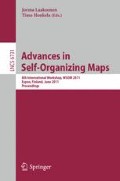Abstract
In recent years, a variety of visualization techniques for visual data exploration based on self-organizing maps (SOMs) have been developed. To support users in data exploration tasks, a series of software tools emerged which integrate various visualizations. However, the focus of most research was the development of visualizations which improve the support in cluster identification. In order to provide real insight into the data set it is crucial that users have the possibility of interactively investigating the data set. This work provides an overview of state-of-the-art software tools for SOM-based visual data exploration. We discuss the functionality of software for specialized data sets, as well as for arbitrary data sets with a focus on interactive data exploration.
Access this chapter
Tax calculation will be finalised at checkout
Purchases are for personal use only
Preview
Unable to display preview. Download preview PDF.
References
Kohonen, T.: The Self-Organizing Map. Proceedings of the IEEE 78(9), 1464–1480 (1990)
Ultsch, A., Siemon, H.P.: Kohonen’s Self Organizing Feature Maps for Exploratory Data Analysis. In: International Neural Networks Conference, pp. 305–308. Kluwer Academic Press, Paris (1990)
Ultsch, A.: Maps for the Visualization of High-Dimensional Data Spaces. In: Workshop on Self-Organizing Maps, pp. 225–230 (2003)
Ultsch, A.: U*-Matrix: A Tool to Visualize Clusters in High Dimensional Data. Technical Report 36, Dept. of Mathematics and Computer Science, University of Marburg, Germany (2003)
Merkl, D., Rauber, A.: Alternative Ways for Cluster Visualization in Self-Organizing Maps. In: Workshop on Self-Organizing Maps, pp. 106–111 (1997)
Pampalk, E., Rauber, A., Merkl, D.: Using Smoothed Data Histograms for Cluster Visualization in Self-Organizing Maps. In: Dorronsoro, J.R. (ed.) ICANN 2002. LNCS, vol. 2415, pp. 871–876. Springer, Heidelberg (2002)
Pölzlbauer, G., Rauber, A., Dittenbach, M.: Advanced visualization techniques for self-organizing maps with graph-based methods. In: Wang, J., Liao, X.-F., Yi, Z. (eds.) ISNN 2005. LNCS, vol. 3497, pp. 75–80. Springer, Heidelberg (2005)
Poelzlbauer, G., Dittenbach, M., Rauber, A.: A Visualization Technique for Self-Organizing Maps with Vector Fields to Obtain the Cluster Structure at Desired Levels of Detail. IEEE International Joint Conference on Neural Networks 3, 1558–1563 (2005)
Poelzlbauer, G., Dittenbach, M., Rauber, A.: Advanced Visualization of Self-Organizing Maps with Vector Fields. Neural Networks 19(6-7), 911–922 (2006)
Tasdemir, K., Merenyi, E.: Exploiting Data Topology in Visualization and Clustering of Self-Organizing Maps. IEEE Transactions on Neural Networks 20(4), 549–562 (2009)
Latif, K., Mayer, R.: Sky-Metaphor Visualisation for Self-Organising Maps. J. Universal Computer Science (7th International Conference on Knowledge Management), 400–407 (2007)
Vesanto, J.: SOM-based Data Visualization Methods. Intelligent Data Analysis 3, 111–126 (1999)
Mayer, R., Aziz, T.A., Rauber, A.: Visualising Class Distribution on Self-Organising Maps. In: de Sá, J.M., Alexandre, L.A., Duch, W., Mandic, D.P. (eds.) ICANN 2007. LNCS, vol. 4669, pp. 359–368. Springer, Heidelberg (2007)
Rauber, A.: LabelSOM: on the Labeling of Self-Organizing Maps. In: International Joint Conference on Neural Networks, vol. 5, pp. 3527–3532 (1999)
Neumayer, R., Mayer, R., Polzlbauer, G., Rauber, A.: The Metro Visualisation of Component Planes for Self-Organising Maps. In: International Joint Conference on Neural Networks, pp. 2788–2793 (2007)
Dzemyda, G., Kurasova, O.: Comparative Analysis of the Graphical Result Presentation in the SOM Software. Informatica 13(3), 275–286 (2002)
Keim, D., Mansmann, F., Schneidewind, J., Ziegler, H.: Challenges in Visual Data Analysis. In: 10th International Conference on Information Visualization, pp. 9–16 (2006)
Heidemann, G., Saalbach, A., Ritter, H.: Semi-Automatic Acquisition and Labelling of Image Data Using SOMs. In: European Symposium on Artificial Neural Networks, pp. 503–508 (2003)
Bekel, H., Heidemann, G., Ritter, H.: Interactive image data labeling using self-organizing maps in an augmented reality scenario. Neural Networks 18(5-6), 566–574 (2005)
Moehrmann, J., Bernstein, S., Schlegel, T., Werner, G., Heidemann, G.: Optimizing the Usability of Interfaces for the Interactive Semi-Automatic Labeling of Large Image Data Sets. In: HCI International. LNCS, Springer, Heidelberg (to appear, 2011)
Schreck, T., Bernard, J., von Landesberger, T., Kohlhammer, J.: Visual Cluster Analysis of Trajectory Data with Interactive Kohonen Maps. Information Visualization 8, 14–29 (2009)
Torkkola, K., Gardner, R.M., Kaysser-Kranich, T., Ma, C.: Self-Organizing Maps in Mining Gene Expression Data. Information Sciences 139(1-2), 79–96 (2001)
Kanaya, S., Kinouchi, M., Abe, T., Kudo, Y., Yamada, Y., Nishi, T., Mori, H., Ikemura, T.: Analysis of Codon Usage Diversity of Bacterial Genes with a Self-Organizing Map (SOM): Characterization of Horizontally Transferred Genes with Emphasis on the E. Coli O157 Genome. Gene 276(1-2), 89–99 (2001)
Simple-BL SOM Website, http://kanaya.naist.jp/SOM/
Vesanto, J., Himberg, J., Alhoniemi, E., Parhankangas, J.: Self-Organizing Map in Matlab: the SOM toolbox. In: Matlab DSP Conference, pp. 35–40 (1999)
SOMVis, TU Wien, http://www.ifs.tuwien.ac.at/dm/somvis-matlab/index.html
Java SOMToolbox, TU Wien, http://www.ifs.tuwien.ac.at/dm/somtoolbox/
Peltarion Synapse, http://www.peltarion.com/products/synapse/
Viscovery SOMine, http://www.viscovery.net/somine/
VisiSOM, http://www.visipoint.fi/visisom.php
Author information
Authors and Affiliations
Editor information
Editors and Affiliations
Rights and permissions
Copyright information
© 2011 Springer-Verlag Berlin Heidelberg
About this paper
Cite this paper
Moehrmann, J., Burkovski, A., Baranovskiy, E., Heinze, GA., Rapoport, A., Heidemann, G. (2011). A Discussion on Visual Interactive Data Exploration Using Self-Organizing Maps. In: Laaksonen, J., Honkela, T. (eds) Advances in Self-Organizing Maps. WSOM 2011. Lecture Notes in Computer Science, vol 6731. Springer, Berlin, Heidelberg. https://doi.org/10.1007/978-3-642-21566-7_18
Download citation
DOI: https://doi.org/10.1007/978-3-642-21566-7_18
Publisher Name: Springer, Berlin, Heidelberg
Print ISBN: 978-3-642-21565-0
Online ISBN: 978-3-642-21566-7
eBook Packages: Computer ScienceComputer Science (R0)

